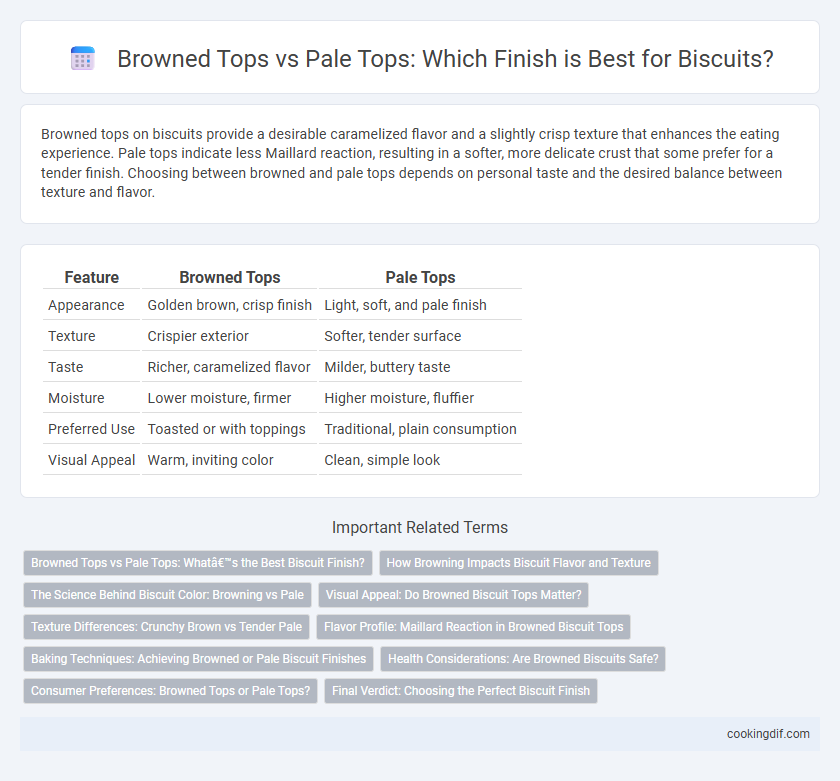Browned tops on biscuits provide a desirable caramelized flavor and a slightly crisp texture that enhances the eating experience. Pale tops indicate less Maillard reaction, resulting in a softer, more delicate crust that some prefer for a tender finish. Choosing between browned and pale tops depends on personal taste and the desired balance between texture and flavor.
Table of Comparison
| Feature | Browned Tops | Pale Tops |
|---|---|---|
| Appearance | Golden brown, crisp finish | Light, soft, and pale finish |
| Texture | Crispier exterior | Softer, tender surface |
| Taste | Richer, caramelized flavor | Milder, buttery taste |
| Moisture | Lower moisture, firmer | Higher moisture, fluffier |
| Preferred Use | Toasted or with toppings | Traditional, plain consumption |
| Visual Appeal | Warm, inviting color | Clean, simple look |
Browned Tops vs Pale Tops: What’s the Best Biscuit Finish?
Browned tops on biscuits indicate Maillard reaction development, resulting in richer flavor and appealing texture compared to pale tops, which suggest less caramelization. The optimal biscuit finish balances a golden-brown crust with a tender interior, providing both visual appeal and enhanced taste. Achieving a browned top requires proper oven temperature and baking time to ensure thorough browning without overcooking.
How Browning Impacts Biscuit Flavor and Texture
Browning on biscuit tops develops complex Maillard reaction flavors, enhancing the taste with a rich, toasty aroma and subtle caramel notes. The golden-brown crust creates a slightly crisp texture, contrasting with the soft, fluffy interior for a satisfying bite. In comparison, pale tops tend to yield a milder flavor and a softer, less structured surface, resulting in a more delicate overall mouthfeel.
The Science Behind Biscuit Color: Browning vs Pale
The science behind biscuit color centers on the Maillard reaction, where amino acids and reducing sugars react under heat to create browned tops with rich flavors and aromas. Pale tops result from lower oven temperatures or shorter baking times, limiting surface caramelization and Maillard browning. Controlling baking conditions precisely influences both the visual appeal and the sensory qualities of finished biscuits.
Visual Appeal: Do Browned Biscuit Tops Matter?
Browned biscuit tops enhance visual appeal by signaling a well-baked, flavorful product with a desirable golden crust. Pale tops may appear undercooked or less appetizing, potentially affecting consumer perception despite the biscuit's texture and taste. The contrast in biscuit top color directly influences purchasing decisions and perceived quality in bakery presentation.
Texture Differences: Crunchy Brown vs Tender Pale
Browned tops on biscuits create a crunchy texture due to Maillard reaction caramelization, offering a crisp bite that contrasts with softer interiors. Pale tops result in a tender, soft finish with minimal crust formation, yielding a fluffier mouthfeel throughout the biscuit. Texture differences between crunchy brown and tender pale finishes influence biscuit appeal in terms of mouthfeel and enjoyment preferences.
Flavor Profile: Maillard Reaction in Browned Biscuit Tops
Browned biscuit tops develop a richer, more complex flavor profile due to the Maillard reaction, which occurs when amino acids and reducing sugars interact under heat. This chemical process creates savory, caramelized notes and a deeper color, enhancing the sensory appeal of the biscuit. In contrast, pale tops indicate less Maillard reaction, resulting in a milder, less developed flavor and a softer texture.
Baking Techniques: Achieving Browned or Pale Biscuit Finishes
Achieving a browned top on biscuits requires higher oven temperatures and often a brushed egg wash or milk glaze to promote Maillard reaction and caramelization, resulting in a rich, golden crust. Pale tops are achieved by baking at lower temperatures or shielding the tops with foil during baking to limit browning while ensuring the interior remains tender and fully cooked. Adjusting oven rack position and baking time finely tunes the biscuit finish, catering to desired texture and appearance in artisanal and commercial baking.
Health Considerations: Are Browned Biscuits Safe?
Browned biscuit tops result from the Maillard reaction, which enhances flavor but can produce compounds like acrylamide, a potential health concern if consumed excessively. Pale-topped biscuits have lower levels of these compounds, making them a safer option for individuals monitoring acrylamide intake. Moderate consumption of browned biscuits is generally safe, but balancing with pale options reduces exposure to harmful substances.
Consumer Preferences: Browned Tops or Pale Tops?
Consumers often prefer browned tops on biscuits for their rich, caramelized flavor and appealing golden color, which suggests a well-baked product. Pale tops may appeal to those seeking a softer texture and a milder taste, often associated with less baking time or lower heat. Market studies indicate a strong preference for browned tops in traditional biscuit varieties, linking visual cues to perceived freshness and quality.
Final Verdict: Choosing the Perfect Biscuit Finish
Browned tops on biscuits offer a rich, caramelized flavor and a visually appealing golden crust, enhancing both taste and texture, while pale tops indicate a softer, more tender biscuit interior with a milder finish. The ideal biscuit finish depends on personal preference; those seeking a crunchier, more robust bite favor browned tops, whereas lovers of delicate, fluffy biscuits prefer pale tops. Evaluating the desired eating experience and recipe goals ensures the perfect biscuit finish every time.
Browned tops vs pale tops for finish Infographic

 cookingdif.com
cookingdif.com